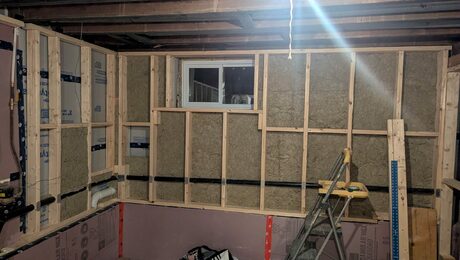To belt or not to belt – that is the question.
The next few weeks I’m doing more laminate work on old table tops – rough agressive sanding that has to be flat – and three sheets of laminate that we have are disconinued and are the last three in existance and it’s very glossy so prep has to be perfect……and as much as I hate to admit it, I liked the way a buddies belt sander has been working compared to my disk.
I’ve liked the heavy 4″ porter cable and at first I liked a 4″ Bosch, but after using the Bosch the belt moved all over the place and the bearings sounded like something was wrong – and it’s fairly new – not a big confidence builder. The 4″ PC seemed solid and built like a tank, but not always the best finesse tool.
Do I want a 3″ since I will have limited use of the big belt job after the next few weeks? I just have never used one enough to feel great about using a belt in odd angles – the disk seems second nature…..or do I simply stay with the disk and spend the extra money on dinner and movie tickets for the little lady?















Replies
First, I feel sorry for you if you are using glossy LP on a table top, it can get scratched just looking at it. Make sure you take extra precautions like putting tape on the bottom of your router plate, using euro style square bearings on the trimming bits and don't let anyone breathe on it.
I'm both a cabinetmaker and carpenter so I probably have more use and more experience with belt sanders than most. I wouldn't consider using a disk sander to flatten a wood top. Wouldn't want to put LP on solid wood without a clearly written agreement with the customer about potential problems. You should think about using a backer sheet on the opposite face or the top may curl up.
I have both 3x21 and 4x24 belt sanders. There isn't a lot of size difference measurement wise but there is a huge difference in performance, heft and bearing surface. If you don't have a lot of experience with belt sanders, they can make a big mess in a hurry. You have to keep them flat, moving and don't run over the chord or have it hang up. The newer PC 4" belts have variable speed, excellent belt tracking, dust collection that is very good and a great feel. It's a tool that really shows where HD industrial PC tools are at the top of the chain. Sounds like the Bosch you used was done for, so don't use that as a comparison to anything, broke is broke.
When it comes to flattening large surfaces, go with the bigger sander. It will make the job much easier, mostly due to the bearing surface and the way it will sit on the work. Too much chance of wiggle, chatter and tipping with the 3". It will feel like half the tool compared to the 4". Tool costs are deductable if you are in the business and you could always sell it if you have no further use for it. The bigger sander may save time and aggrevation so you make enough to take the Mrs. out instead of working extra hours trying to fix things.
The table tops aren't solid wood, but they do have a 2" band of solid wood around the perimeter (there is a huge supply of these on site and so far it makes sense to reuse the old tops rather than make new.
This stuff is so glossy it's crazy and it scratches easily with light fingernail pressure, but luckily the existing tables that have already been covered have a few months of bar wear and tear on them so you can imagine what they look like and management isn't expecting them to stay scratch free for long. There is a little sparkle in it so the scratches don't all look like scratches at least in dim light! lol
People are supprised how good a flat backer on my vs disk sander works at flattening - but I see how I need to probably get both sizes of belt sanders.
I had a Bosch 1274DVS 3-inch belt sander, and it was a piece of excrement. The dust path was long and crooked and would clog regularly, requiring a 10 minute disassembly. The cheapo friction pad under the belt wore out quickly. The belts wouldn't stay straight and fayed along one edge. And when one of the idler roller bearings went out I tossed it and got a 3" PC instead.